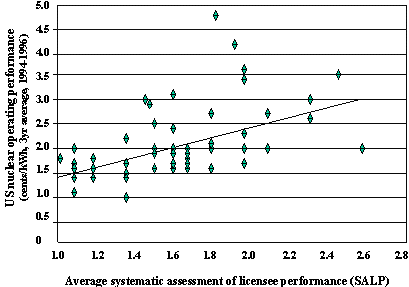Most of the world’s electricity markets are now moving towards greater competition, driven in part by technology, and in part by experience that competitive markets are more self-sustaining. Increased competition has generally led to a downward tendency in the price of electricity generation when compared to prices received under more protected and monopolistic market structures.
This is true both in markets where demand is stagnant and where it is growing. Power companies increasingly need a commercial, profit-oriented approach to doing business if they are to survive and prosper. Freed from their traditional regulated and social monopoly status, they will focus on supply technologies that are low cost and low risk, and hence more profitable in a competitive market. Off-the-rack instead of tailor made plants and equipment will be the fashion, and rapid, high and secure returns more of a requirement. Even more, generators will need to make substantial cost reductions over the next few years. In general, nuclear power has the potential to be a competitive contender but realising that potential will require significant changes in the way the industry and its regulators do business.
Existing Plants
Nuclear power plants already built have generally fared well in restructured markets. The operating costs of nuclear power plants, including fuel costs, are usually lower than for most other major power generation alternatives, with the exception of hydroelectricity. Capital is largely depreciated and a plant with operating and maintenance costs (O&M) below market prices turns in a profit. In 1999, the most efficient plants saw costs of around US$ 0.011 per kWh. Moreover, the cost trend is still downward leading to optimistic anticipation that even lower operating costs are possible in the near future. Similar low and declining operating costs are experienced in other economies.
Advertisement
But while more than half the nuclear sites in the USA are considered competitive in changing markets, with two-thirds of the units producing power for under US$ 0.02 per kWh, yet others have costs of US$ 0.06–0.13 per kWh. In the United Kingdom, each of British Energy’s eight privatized nuclear stations sells power profitably at competitive market prices (an average of around US$ 0.03 per kWh), while the Magnox plants assigned to BNFL are still producing at about US$ 0.05 per kWh, or are being closed as uneconomic before the end of their design lifetime.
For nuclear plants, the ability to compete depends on cutting unit costs (especially operating and maintenance costs) without compromising safety, and on increasing plant availability. The importance of good management is emphasized for two reasons. First, a commercial and competitive management approach is new to many electricity and nuclear industry managers, and so bears mention. Second, good management can make a telling difference in the bottom line.
Almost all nuclear plants that are now competitive have made significant if not dramatic improvements over the past decade in their availability, and significant if not dramatic cost reductions. Well managed nuclear plants now enjoy a cost advantage over many other generators but as the average cost of all generation inches lower, operators of nuclear plants will have less of a cost advantage. As net cash flow margins converge under competition, nuclear operators will need to reduce their costs and increase their margins even further to survive.
In this regard, cost-effective safety regulation is crucial to the continued profitability of existing nuclear power plants. Maintaining high levels of safety is non-negotiable for nuclear plant operators, but the cost of safety compliance, along with other operating costs and on-going capital expenditures, will be a significant factor in management decisions about plant operations.
Spending more money on safety does not necessarily make a plant safer, just as cutting costs does not necessarily make a plant more unsafe. In the USA and the UK, there is a close correlation between nuclear power plants with high efficiencies and those with a high safety performance (see Figure 1). Those commercial plants with the best safety ratings also had the highest availability and the lowest operating cost.

Advertisement
Figure 1: Relationship between Unit Cost of Production of US Nuclear Plants and Regulatory Performance.
Unfinished Plants and Life Extensions
The aging of the world’s nuclear power park and the potential for lifetime extension are matters of considerable current interest that need to be evaluated objectively. Completion of unfinished nuclear power plants, or extending the life of a successful one, can be an economically attractive and practical alternative to building a new plant or to decommissioning an old one.
A decision on project completion, relicensing or life extension of an operating NPP is a comparison of only three elements: net present value (NPV) of the cost of completion versus the NPV of the anticipated future revenue stream from the completed project (generating revenue minus costs, discounted over the amortisation period for the plant), versus the cost of plant closure or stopping construction.
This is an edited extract of a paper presented to the 23rd Annual IAEE International Conference: Energy Market and the New Millennium: Economic, Environment, Security of Supply, Hilton Sydney, Australia, 7-10 June 2000.